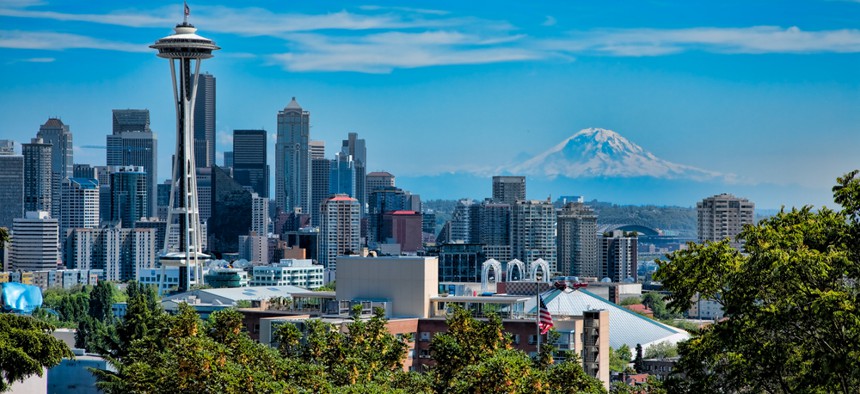Seattle Seeks to Save Its Bus System

Sixty-six percent of Seattle voters approved a bus-funding ballot proposal in April but the majority of King County voters opposed it. Shutterstock
King County, Washington, is out of transit-funding tricks, so officials in its largest city are taking action.
When elected officials in Washington state’s King County put a ballot proposal to shore up transit funding to a public vote this past spring, many thought it wouldn’t have trouble passing.
Residents in Seattle, King County’s largest jurisdiction and Washington state’s prime economic driver, are highly dependent on King County Metro’s extensive bus network, which connects neighborhoods, downtown and its transit tunnel with other major employment and activity centers around the city and the greater Seattle metropolitan area.
“I have never seen a campaign this robust. There was a huge outpouring of support” for the measure, known as Proposal 1, King County Council Chairman Larry Phillips said in an interview with GovExec State & Local. “Everyone was lined up to support this.”
That may have been true of bus riders in the city, but King County encompasses an area considerably larger than Seattle. Not only does it include 39 cities, but King’s unincorporated areas would rank as Washington state’s second-most populous jurisdiction if it were its own city, Phillips said.
Although 66 percent of Seattle voters approved Proposal 1, the majority of King County voters overall voted against the measure, which would have raised vehicle license fees for county residents to help fund transit service. The city-suburb divide in the April 22 special election vote was strikingly clear: 55 percent of King County voters turned against the proposal.
“Transit riders were very well informed of the dire situation of our funding problem. The general public was not,” especially suburban residents who may not rely on the bus as much as transit-loving Seattleites, Phillips said.
“It’s a different situation in the suburbs,” said Phillips, who represents a Seattle-based district on the King County Council. “It’s not as highly valued there.”
With the failure of Proposal 1, Seattle and King County bus riders are facing the looming possibility of drastic — and politically unpopular — service cuts. King County Metro is preparing to slash 550,000 annual service hours from the overall bus network after initially proposing to cut more than 600,000 hours. Without a major infusion of funding from the state legislature in Olympia — which is unlikely — it may be up to Seattle to save its bus system.
“We don’t have the luxury of waiting, so this is what we have to do,” said Seattle City Councilmember Tom Rasmussen, who has introduced legislation that would authorize a bus-funding ballot proposal that would go before Seattle voters in November.
“We’re out of tricks, we’re out of options,” Phillips said of King County’s efforts to maintain its transit system.
“The Great Recession put a huge hole in our operational budget,” he said. “$1.2 billion in anticipated revenue didn’t arrive.”
Although neighboring counties simply slashed bus service in their jurisdictions when the economy tanked, King County, Phillips said, found ways to avert transit cuts by consolidating operations, raising fares five times and trimming costs -- including laying off 100 administrative employees.
Overall, King County was able to patch together nearly $800 million in savings, which prompted the state legislature to kick in some limited funding to help keep the bus system’s operations above water. Yet, all those budgetary and operational moves could only do so much.
“We worked really hard to find [the $800 million] …but we knew that was going to come to an end,” Phillips said. “We went to the legislature 10 times over five or six years. They gave us a little two-year reprieve. We were the only county to get it. We did all that we could do.”
When Phillips’ colleagues on the King County Council, boosted by the prospects of higher sales tax revenue, approved legislation following the failure of Proposal 1 aimed at staving off the bus cuts, King County Executive Dow Constantine issued his first-ever veto on June 9.

King County Executive Dow Constantine (Photo courtesy Seattle Mayor's Office)
According to Constantine’s veto message to the council, he said the legislation “spends future revenue that does not exist, and it draws upon one-time revenue to fund ongoing operations. Further, it violates King County Metro’s Council-adopted Strategic Plan by allocating service hours based on political considerations rather than data and established objective criteria. We’ve come far in our nationally recognized work to reform and modernize King County government and should not endanger this progress.”
Although Phillips supports local action to preserve bus service, the plan pushed by his council colleagues did not settle well with him. “Hope is not a plan,” he said. “Until you have those dollars in hand, you’re hoodwinking the public.”
So with no solutions from King County — and certainly none from the state — the ball is in Seattle’s court.
“I have said consistently that when we reached the point where we had no options … [that] Seattle would move to save its system with its dollars,” Phillips said. “It’s in their civic and financial interest to put forward a proposal. I am supportive of that effort.”
Now, with an August deadline rapidly approaching, Seattle leaders have to settle on a plan to put to voters who reside within the Seattle Transportation Benefit District, a local taxing jurisdiction for transportation projects.

Seattle Mayor Ed Murray (Photo courtesy Seattle Mayor's Office)
Mayor Ed Murray’s plan, put forth in Rasmussen’s legislation introduced June 19, would essentially put the core elements of the original Proposal 1 before Seattle voters. That plan calls for increases in sales-and-use taxes and additional vehicle license fees. The plan aims to prevent 90 percent of the cuts planned on Seattle bus routes, but wouldn’t help jurisdictions outside Seattle’s city limits.
Seattle Council members Nick Licata and Kshama Sawant have put forth another proposal, one that would raise revenue for the transit system through a hike in commercial parking and hourly employment taxes instead of boosting sales taxes, as Rasmussen’s legislation does. That plan also aims to preserve Seattle-specific transit service.
“I think we could do better,” Licata told GovExec State & Local. “I don’t think we need to go to the sales tax,” which the council member noted is one of the highest in the nation, which he said could deter businesses from setting up shop inside the city limits.
“Let’s have a discussion,” Licata said on the funding mechanism. He stressed that he’s not opposed to the mayor’s and Rasmussen’s plan. “It’s worthwhile having a discussion.”
Those discussions will continue during a Seattle Transportation Benefit District hearing scheduled for Thursday.
Assuming Seattle leaders settle on a specific plan to put before voters to save their local transit network, it’s only a short-term fix and one that doesn’t address a larger problem that transcends jurisdictional boundaries.
“The regional system is still critically important. We just haven’t figured out a way to save that system,” Phillips said.
(Photo of Seattle via Lonnie Gorsline/Shutterstock.com)






